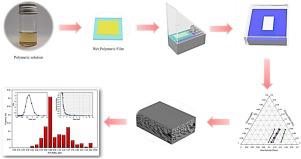当前位置:
X-MOL 学术
›
J. Ind. Eng. Chem.
›
论文详情
Our official English website, www.x-mol.net, welcomes your
feedback! (Note: you will need to create a separate account there.)
Preparation and optimization of antifouling PPSU/PES/SiO2 nanocomposite ultrafiltration membranes by VIPS-NIPS technique
Journal of Industrial and Engineering Chemistry ( IF 5.9 ) Pub Date : 2020-08-01 , DOI: 10.1016/j.jiec.2020.04.028 Amin Dehban , Ali Kargari , Farzin Zokaee Ashtiani
Journal of Industrial and Engineering Chemistry ( IF 5.9 ) Pub Date : 2020-08-01 , DOI: 10.1016/j.jiec.2020.04.028 Amin Dehban , Ali Kargari , Farzin Zokaee Ashtiani

|
Abstract In this paper, the preparation of PPSU/PES/Nano silica composite ultrafiltration membranes by a combined vapor induced phase separation (VIPS) and non-solvent induced phase separation (NIPS) techniques were successfully investigated. For this purpose, the effect of VIPS time from 0 to 60 s, the blending ratio of PPSU:PES from 0 to 100%, polymer concentration from 16 to 24 wt.%, and SiO2 nanoparticles concentration from 0 to 5 wt.% as an additive to dope solution on the performance and characteristics of ultrafiltration membranes were studied. As the number of parameters is high, the response surface methodology (RSM) was applied for designing the experiments for obtaining the optimum condition for the fabrication of a high flux ultrafiltration membrane. Liquid-liquid displacement porosimetry (LLDP), scanning electron microscope (SEM), pure water flux (PWF), and bovine serum albumin (BSA) retention were used for characterization of the fabricated membranes. The results are shown different trends for the effect of SiO2 nanoparticles concentration at the low and high polymer concentrations in dope solution. When the polymer concentration in the dope solution is low, the increase of SiO2 nanoparticles concentration resulted in lower fluxes, but at high polymer concentrations, the increase of the nanoparticles caused an increase in permeate flux. At optimum condition, the highest PWF of 76.65 L/m².h (15.33 L/m².h.bar), and a BSA retention of 82.01% was obtained.
中文翻译:

VIPS-NIPS技术制备防污PPSU/PES/SiO2纳米复合超滤膜及优化
摘要 本文成功研究了气相诱导相分离(VIPS)和非溶剂诱导相分离(NIPS)相结合技术制备PPSU/PES/纳米二氧化硅复合超滤膜。为此,VIPS 时间从 0 到 60 s,PPSU:PES 的混合比从 0 到 100%,聚合物浓度从 16 到 24 wt.%,以及 SiO2 纳米颗粒浓度从 0 到 5 wt.% 的影响为研究了掺杂溶液中添加剂对超滤膜性能和特性的影响。由于参数数量较多,因此应用响应面法 (RSM) 来设计实验,以获得制造高通量超滤膜的最佳条件。液-液置换孔隙度法 (LLDP)、扫描电子显微镜 (SEM)、纯水通量 (PWF) 和牛血清白蛋白 (BSA) 保留用于表征制造的膜。结果显示了掺杂溶液中低和高聚合物浓度下 SiO2 纳米粒子浓度影响的不同趋势。当原液中聚合物浓度较低时,SiO2 纳米粒子浓度的增加导致通量降低,但在聚合物浓度高时,纳米粒子的增加导致渗透通量增加。在最佳条件下,最高 PWF 为 76.65 L/m².h(15.33 L/m².h.bar),BSA 保留率为 82.01%。结果显示了掺杂溶液中低和高聚合物浓度下 SiO2 纳米粒子浓度影响的不同趋势。当原液中聚合物浓度较低时,SiO2 纳米粒子浓度的增加导致通量降低,但在聚合物浓度高时,纳米粒子的增加导致渗透通量增加。在最佳条件下,最高 PWF 为 76.65 L/m².h(15.33 L/m².h.bar),BSA 保留率为 82.01%。结果显示了掺杂溶液中低和高聚合物浓度下 SiO2 纳米粒子浓度影响的不同趋势。当原液中聚合物浓度较低时,SiO2 纳米粒子浓度的增加导致通量降低,但在聚合物浓度高时,纳米粒子的增加导致渗透通量增加。在最佳条件下,最高 PWF 为 76.65 L/m².h(15.33 L/m².h.bar),BSA 保留率为 82.01%。
更新日期:2020-08-01
中文翻译:

VIPS-NIPS技术制备防污PPSU/PES/SiO2纳米复合超滤膜及优化
摘要 本文成功研究了气相诱导相分离(VIPS)和非溶剂诱导相分离(NIPS)相结合技术制备PPSU/PES/纳米二氧化硅复合超滤膜。为此,VIPS 时间从 0 到 60 s,PPSU:PES 的混合比从 0 到 100%,聚合物浓度从 16 到 24 wt.%,以及 SiO2 纳米颗粒浓度从 0 到 5 wt.% 的影响为研究了掺杂溶液中添加剂对超滤膜性能和特性的影响。由于参数数量较多,因此应用响应面法 (RSM) 来设计实验,以获得制造高通量超滤膜的最佳条件。液-液置换孔隙度法 (LLDP)、扫描电子显微镜 (SEM)、纯水通量 (PWF) 和牛血清白蛋白 (BSA) 保留用于表征制造的膜。结果显示了掺杂溶液中低和高聚合物浓度下 SiO2 纳米粒子浓度影响的不同趋势。当原液中聚合物浓度较低时,SiO2 纳米粒子浓度的增加导致通量降低,但在聚合物浓度高时,纳米粒子的增加导致渗透通量增加。在最佳条件下,最高 PWF 为 76.65 L/m².h(15.33 L/m².h.bar),BSA 保留率为 82.01%。结果显示了掺杂溶液中低和高聚合物浓度下 SiO2 纳米粒子浓度影响的不同趋势。当原液中聚合物浓度较低时,SiO2 纳米粒子浓度的增加导致通量降低,但在聚合物浓度高时,纳米粒子的增加导致渗透通量增加。在最佳条件下,最高 PWF 为 76.65 L/m².h(15.33 L/m².h.bar),BSA 保留率为 82.01%。结果显示了掺杂溶液中低和高聚合物浓度下 SiO2 纳米粒子浓度影响的不同趋势。当原液中聚合物浓度较低时,SiO2 纳米粒子浓度的增加导致通量降低,但在聚合物浓度高时,纳米粒子的增加导致渗透通量增加。在最佳条件下,最高 PWF 为 76.65 L/m².h(15.33 L/m².h.bar),BSA 保留率为 82.01%。









































 京公网安备 11010802027423号
京公网安备 11010802027423号